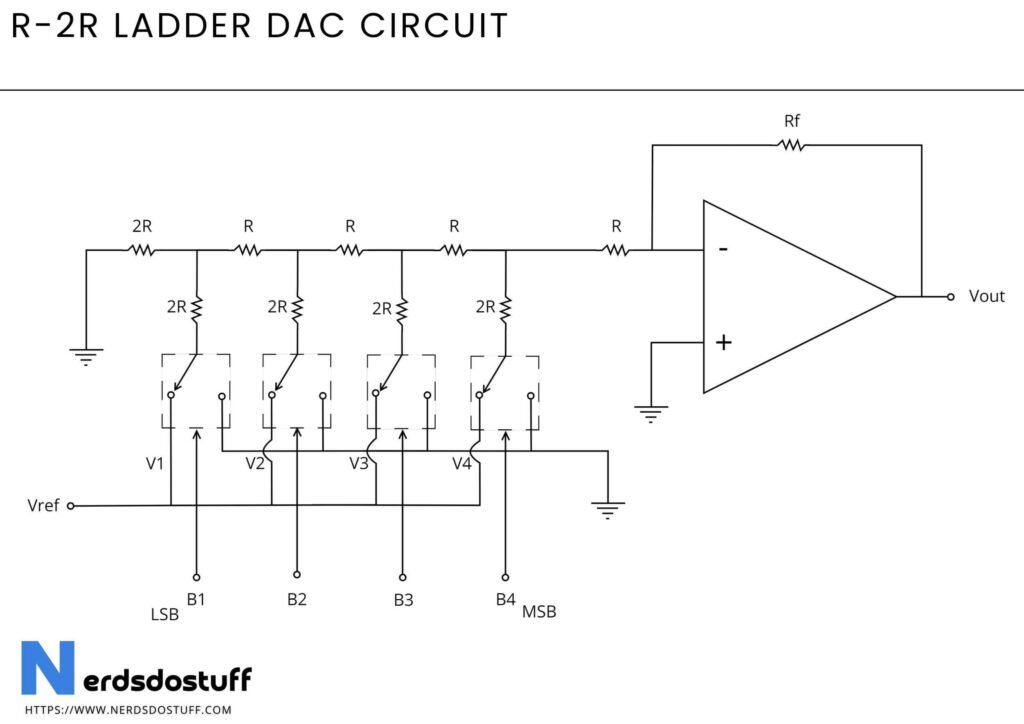What is R-2R Ladder DAC ?
An R-2R ladder DAC is a type of digital-to-analog converter that uses a simple and repetitive network of resistors with only two values: R and 2R. The R-2R ladder network creates a binary-weighted voltage divider. This structure allows for efficient and accurate conversion of digital binary signals into corresponding analog voltages. The key advantage of the R-2R ladder DAC over other types, like the weighted resistor DAC, is that it requires only two resistor values regardless of the number of bits, simplifying manufacturing and improving precision.
The operation of an R-2R ladder DAC involves switching digital inputs that correspond to binary values. Each switch controls whether the corresponding bit contributes to the output voltage. When a switch connects to the reference voltage, it contributes its weighted value; when connected to ground, it contributes nothing. This design ensures that the output voltage is a precise analog representation of the digital input. The R-2R ladder is widely used in digital audio, signal processing, and microcontroller applications due to its simplicity, scalability, and consistent performance across various bit depths.
R-2R Ladder DAC Circuit

Working R-2R Ladder DAC
The R-2R ladder DAC operates by using a network of resistors arranged in a repeating pattern of R and 2R values, forming a binary-weighted voltage divider. Each bit of the digital input controls a switch that connects either to a reference voltage or to ground. The most significant bit (MSB) has the largest influence on the output voltage, while the least significant bit (LSB) has the smallest. When a bit is high (1), its corresponding switch connects to the reference voltage; when low (0), it connects to ground. This configuration ensures that each bit contributes a precise fractional voltage based on its position in the binary sequence.
The summing point of the R-2R network is typically connected to an operational amplifier, which helps in maintaining the output impedance and providing a stable analog output voltage. The resulting output voltage is a sum of the contributions from each bit, weighted appropriately by the resistor network. This analog voltage is proportional to the binary value of the digital input.
Applications of R-2R Ladder DAC
- Audio Equipment:
- R-2R ladder DACs are widely used in audio equipment such as CD players, digital audio players, and sound cards for computers. They convert digital audio signals into precise analog voltages for playback through speakers or headphones, offering high-quality sound reproduction.
- Measurement and Instrumentation:
- In test and measurement equipment, R-2R ladder DACs are employed to generate precise analog signals from digital inputs. They are used in oscilloscopes, signal generators, and data acquisition systems for various applications, including sensor calibration, waveform generation, and signal conditioning.
- Industrial Control Systems:
- R-2R ladder DACs play a crucial role in industrial control systems, where they convert digital control signals into corresponding analog voltages to drive actuators, motors, and other analog-controlled devices. These DACs ensure accurate and reliable control of industrial processes and machinery.
- Telecommunications:
- In telecommunications systems, R-2R ladder DACs are utilized for digital-to-analog conversion in applications such as baseband signal processing, modulation, and demodulation. They enable the conversion of digital signals into analog form for transmission over analog channels, ensuring efficient communication in devices like modems, routers, and telecommunication networks.




